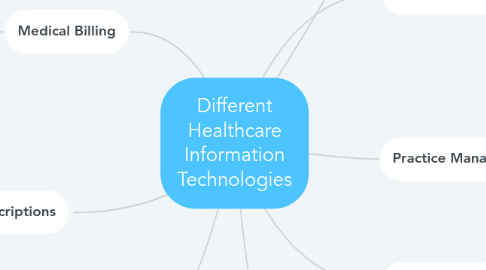Different Healthcare Information Technologies
Amber Curllにより

1. Electronic Heath Records
1.1. Focuses on the total health of the patient
1.2. Allows all members of the team to have ready access to the latest information allowing for more coordinated, patient-centered care.
1.3. The information moves with the patient—to the specialist, the hospital, the nursing home, the next state or even across the country.
2. Medical Billing
2.1. Allows for effective management of billing claims to insurance companies and patients
2.2. Reduces costs by eliminating paper billing and postage by transmitting via the internet
2.3. Allows for electronic payments which received more quickly
3. ePrescriptions
3.1. Reduces medication errors
3.2. Improves patient convenience by sending the prescription electronically to the patients preferred pharmacy
3.3. Speeds up prescription refill requests
4. Electronic Disease Registries
4.1. Data included in the registry can be important in assisting clinicians with appropriate preventive maintenance and disease management.
4.2. Produce population reports to monitor and stratify patients.
4.3. Generate exception reports to identify patients who are not meeting management goals.
5. Electronic Medical Records (EMR)
5.1. Digital version of the paper charts.
5.2. Tracks data over time
5.3. Monitor and improve overall quality of care
6. Patient Portal
6.1. Gives patient medical information in order to be more proactive in their own care
6.2. Allows patient to book appointments and keep track of upcoming appointments and procedures
7. Practice Management
7.1. Allows practice to run more effciently
7.2. Integration with hospital affiliation
7.3. Easily identify which patients are due for preventive screenings or checkups
8. Telehealth
8.1. Expands access to care and reaches more patients
8.2. Reduces practice overhead
8.3. Cuts patient costs


